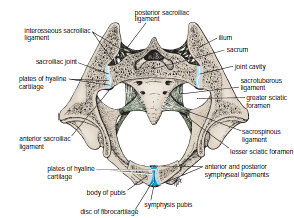Fractures
of the Pelvis
Fractures of the False Pelvis
direct trauma occasionally cause Fractures of the false
pelvis. The upper part of the ilium is seldom displaced because of the
attachment of the iliacus muscle on the inside and the gluteal muscles on the
outside.
Fractures of the True Pelvis
The pelvis as a rigid ring not only as a basin. The ring is
made up of the pubic rami, the ischium, the acetabulum, the ilium, and the
sacrum, joined by strong ligaments at the sacroiliac and symphyseal joints. If the
ring breaks at any one point, the fracture will be stable and no displacement
will occur. However, if two breaks occur in the ring, the fracture will be
unstable and displacement will occur, Fracture of bone on either side of the
joint is more common than disruption of the joint.
because the postvertebral and abdominal muscles will shorten and elevate the lateral part of the pelvis. The break in the ring may occur not as the result of a fracture but as the result of disruption of the sacroiliac or symphyseal joints. The forces responsible for the disruption of the bony ring may be anteroposterior compression, lateral compression, or shearing.
because the postvertebral and abdominal muscles will shorten and elevate the lateral part of the pelvis. The break in the ring may occur not as the result of a fracture but as the result of disruption of the sacroiliac or symphyseal joints. The forces responsible for the disruption of the bony ring may be anteroposterior compression, lateral compression, or shearing.
A heavy fall on the greater trochanter of the femur may
drive the head of the femur through the floor of the acetabulum into the pelvic
cavity.
Fractures of the Sacrum and Coccyx
Fractures of the lateral mass of the sacrum may occur as
part of a pelvic fracture. Fractures of the coccyx are rare. However, coccydynia
is common and is usually caused by direct trauma to the coccyx, as in falling
down a flight of concrete steps. The anterior surface of the coccyx can be
palpated with a rectal examination.
Minor Fractures of the Pelvis
The anterior superior iliac spine may be pulled off by the
forcible contraction of the sartorius muscle in athletes. In a similar manner,
the anterior inferior iliac spine may be avulsed by the contraction of the
rectus femoris muscle. The ischial tuberosity can be avulsed by the contraction
of the hamstring muscles. Healing may occur by fibrous union, possibly
resulting in elongation of the muscle unit and some reduction in muscular
efficiency.
Anatomy
of Complications of Pelvic Fractures
Fractures of the true pelvis are commonly associated with
injuries to the soft pelvic tissues.
If damaged, the thin pelvic veins—namely, the internal iliac
veins and their tributaries—that lie in the parietal pelvic fascia beneath the
parietal peritoneum can be the source of a massive hemorrhage, which may be
life threatening.
The male urethra is often damaged, especially in vertical shear fractures that may disrupt the urogenital diaphragm.
The male urethra is often damaged, especially in vertical shear fractures that may disrupt the urogenital diaphragm.
The bladder, which lies immediately behind the pubis in both
sexes, is occasionally damaged by spicules of bone; a full bladder is more
likely to be injured than an empty bladder .
The rectum lies within the concavity of the sacrum and is
protected and rarely damaged. Fractures of the sacrum or ischial spine may be
thrust into the pelvic cavity, tearing the rectum. Nerve injuries can follow
sacral fractures; the laying down of fibrous tissue around the anterior or
posterior nerve roots or the branches of the sacral spinal nerves can result in
persistent pain.
Damage to the sciatic nerve may occur in fractures involving
the boundaries of the greater sciatic notch. The peroneal part of the sciatic
nerve is most often involved, resulting in the inability of a conscious patient
to dorsiflex the ankle joint or failure of an unconscious patient to reflexly
plantar-flex (ankle jerk) the foot



No comments:
Post a Comment